Rumor holds the Animate Objects spell was inspired by the Sorcerer’s Apprentice short from Disney’s Fantasia (1940), where Mickey animates brooms to carry his water.
Animate Objects is a 5th level spell in D&D 5th Edition that turns objects in your environment into weapons. DM David recently observed that this spell suffers from two mechanical issues:
- Tiny objects are always the best option.
- Numerous attacks grind combat to a halt.
Thankfully, both of these problems are fixable. Let’s unpack the spell and see what we can do to tweak it. Our goal here is not necessarily to come up with a solution (we do), but to give you the tools to understand and adjust the spell to your taste.
How It Works
The spell animates a certain number of objects based on their size:
- Tiny and Small targets count as one object,
- Medium targets count as two objects,
- Large targets count as four objects,
- Huge targets count as eight objects.
These objects gain different statistics based on their size. Here’s the main ones:
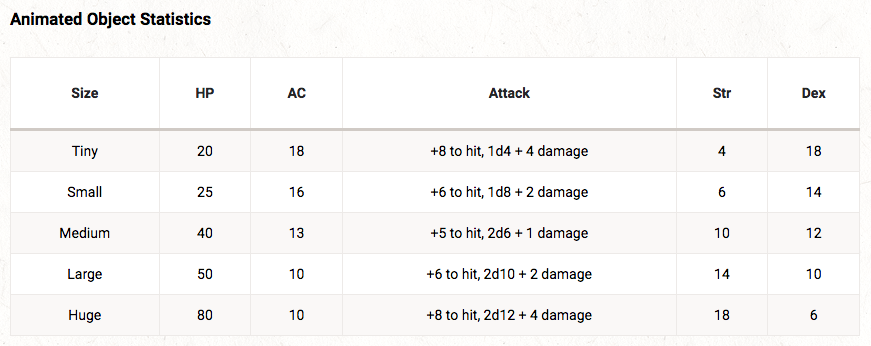
Analysis
There’s three components to analyze: offense, action economy, and defense.
Offense
- Attack bonuses are an inverse bell curve from tiny to huge (ranging +8 to +5).
- Damage increases from smallest to largest (average 6.5 to 17).
These points suggest that bigger objects hit harder. That’s mostly true, though medium objects are the weakest attackers pound-for-pound.
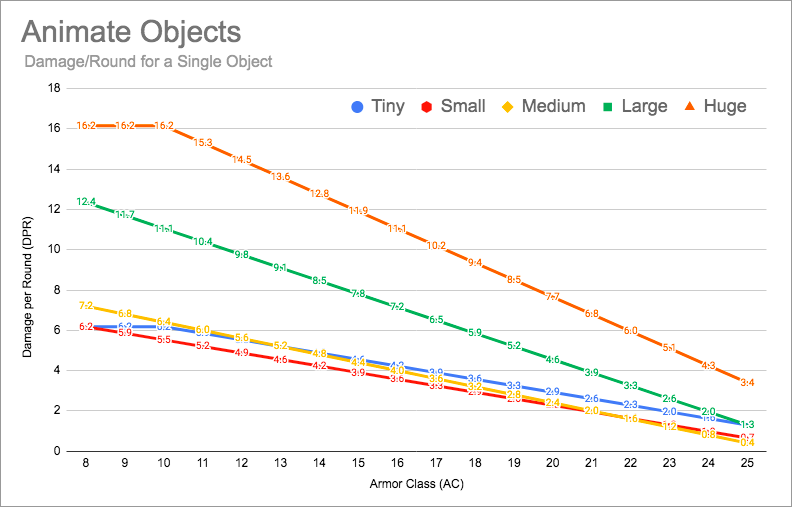
This doesn’t bear out in total damage. While larger objects may hit harder, action economy quickly takes over. As a result, tiny objects are always the best offensive option. The bigger your targeted objects get, the less potent they become. Observe the stark difference:
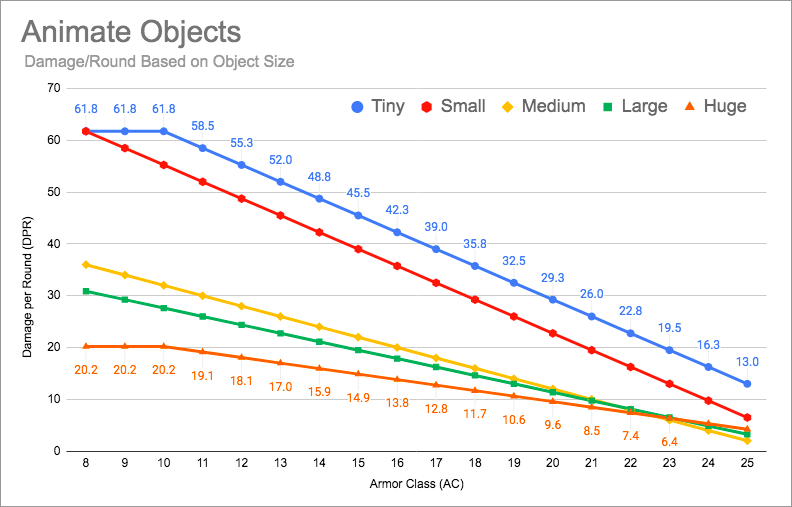 Note: To be fair to the big boys, their calculations are based on a pro rata fraction of the 10 objects you get. Effectively, we’re counting 2.5 large objects and 1.25 huge objects.
Note: To be fair to the big boys, their calculations are based on a pro rata fraction of the 10 objects you get. Effectively, we’re counting 2.5 large objects and 1.25 huge objects.
Action Economy
Knowing that tiny objects are always the best solution, Animate Objects encourages the spellcaster to pick the option that requires 10 attack rolls. Since it takes a bonus action to proc, you’re also grappling with the usual lengthy spellcaster action on successive turns. This becomes very time consuming, which can disengage other players.
Defense
There’s a couple trends to note before we dive in:
- Smaller objects have higher Armor Class (AC) but fewer Hit Points (HP).
- Larger objects have lower AC and more HP.
Smaller Objects. Being multiple objects helps defense, for several reasons:
- The total HP for all the objects is higher.
- Each object needs to be targeted separately.
- Each object takes at least one attack to destroy.
- When an object is destroyed, any “overkill” damage is lost.
- The spell makes some objects harder to hit because they can fly!
Even reducing this down to total HP, smaller objects take longer to destroy. Here’s an example using the Dungeon Master’s Guide‘s suggested stats for a CR 9 creature (+7 attack, 57 damage/round):

Larger Objects. The benefit of larger objects is twofold:
Larger objects maintain their full offensive potency until they’re destroyed, whereas a collection of smaller objects will see their offensive prowess wane as they are dispatched. But, you need to get rid of a solid number of small objects before the damage levels out. It only takes three coins (tiny) to outdamage a bulldozer (huge)!
Swarms of smaller objects are susceptible to area of effect (AoE) damage. It’s no surprise that Shatter is Animate Object’s worst enemy. But, with a 30 foot flying range, the mage has effective means to spread this risk.
The Fix
It’s clear that we need to tweak the stats for object classes. Not only to make it an interesting mechanical choice. We need to balance it enough that the player doesn’t feel cheated enlivening whatever object fits the narrative. There are several things we can do to balance the spell.
Offense
First, we need to balance the offensive potency of the objects.
Setting a Benchmark
The question is whether to nerf the tiny/small objects, or to buff the medium/large/huge objects. So, we need to set a benchmark. Benchmarking the potency of this spell is not so simple, but we need to start somewhere. For that, we turn to the Dungeon Master’s Guide:
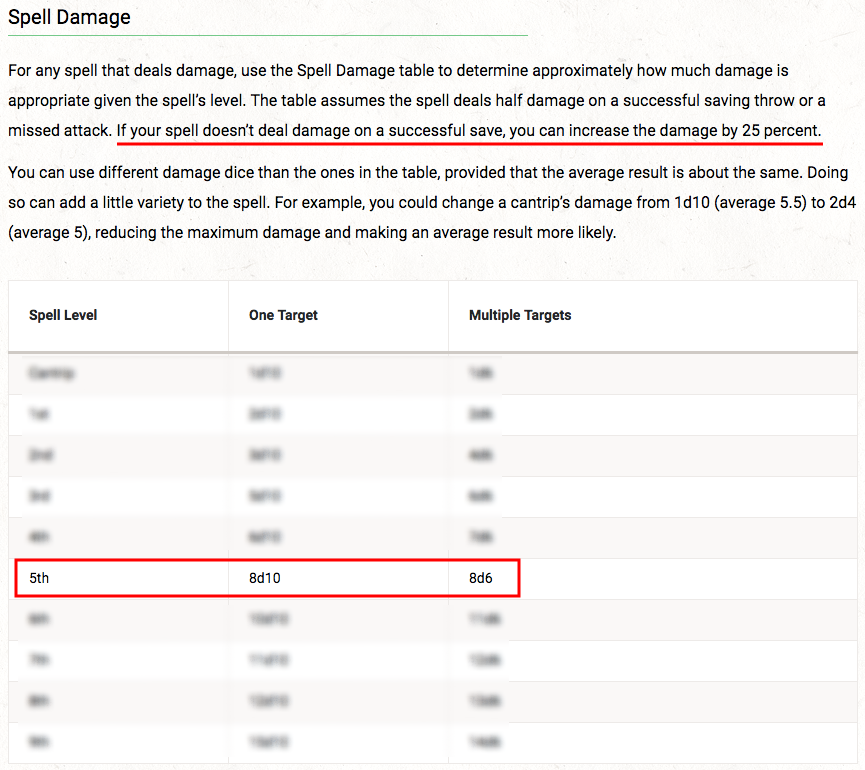
For a spell that works based on attacks, it’s appropriate to use the single target damage benchmark, with the 25% markup (since attacks don’t deal half damage on a miss). That sets our benchmark at 10d10.
But, that assumes that the spell only deals damage once. How do we balance for a spell that deals damage on successive turns? There’s no guidance for that, but we can look to general design principles and other spells as a template.
General Design Philosophy
When designing, we assume that combat will last 3 rounds. That means: if we’re going to divide up the damage a spell deals, we should assume that it’s not going to have more than three turns to deal it.
That doesn’t mean you can just divide damage by three and call it a day. After all, you never know if that second or third turn damage will come. You would always take 99 damage now over 33 damage over the next three turns. Damage that happens now can remove agents from combat. There should be some value to waiting, beyond getting extra damage if combat runs longer than expected.
Assuming three turn combat, the floor should be 18.3 average damage per turn.
Other Spell Comparisons
Summon Celestial Spirit. The latest design in the summoning space is this March 2020 Unearthed Arcana. We can use the 5th level spell Summon Celestial Spirit for to get an approximation of how the designers might benchmark the damage these days. It’s worth noting that the summon will follow verbal instructions, and does not require a bonus action to command.
These summon spells come with a stat block. While the damage in the stat block scales based on the spell level, we can assume it’s cast at base level 5 and back out the average damage per turn:
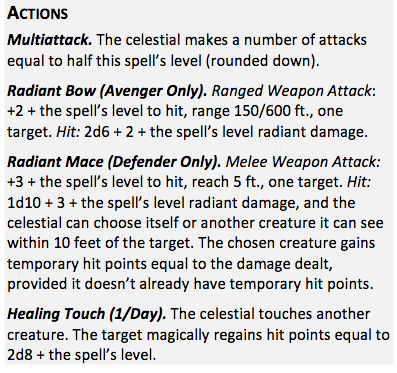
It makes sense to compare the stronger mace attack, since the spirit can move around the battlefield like animated objects. Radiant Mace attacks twice at +8 and deals 13.5 damage/hit. We can assume this damage is tuned down a bit to account for the healing rider. That doesn’t change our calculation, but it’s something to keep in mind when setting our own benchmark.
While matching the high range of the Animate Objects attack bonuses, Summon Celestial Spirit deals 27 average damage per turn.
Spiritual Weapon (upcast). In terms of structure, there are few spells more comparable than Spiritual Weapon. They’re both pseudo-summon spells that make attacks when the caster uses a bonus action.
Since Spiritual Weapon has a less onerous initial casting, doesn’t require concentration, and can’t be killed, Animate Objects needs to deal more damage to justify its comparative deficiencies.
Note: The standard assumption is that you would have maxed your spellcasting ability score by level 9, so we’ll plug in a +5 for the spellcasting ability modifier to our calculations. This won’t be true in every case, but it’s close.
Spiritual Weapon is a melee spell attack (+8) that does damage equal to 1d8 + your spellcasting ability modifier.
Unfortunately, the damage scaling is kind of wonky. Spiritual Weapon only increases damage when upcast to 4th level (2d8+5) or 6th level (3d8+5). Taking the middle puts Spiritual Weapon at 16.25 average damage per turn at a hypothetical 5th level upcast.
Solutions
The question is where to set the benchmarks.
Attack. Considering both Summon Celestial Spirit and Spiritual Weapon attack at +8, it seems to be a good choice. Perhaps it should be a midpoint and not the end of the curve. Perhaps we shouldn’t have a curve at all. If +8 attack is the right thing for a 5th level spell, it makes some sense to apply it uniformly. Using dynamic attack bonuses requires adjusting the damage dice to compensate, the result of which will vary depending on the AC of their target.
Damage. In consideration of everything above, I’m comfortable setting damage at 50% of the recommended 10d10 spell damage. This gives us ~27.5 average damage, which we can break down however we want. Remember that the smaller dice you use, the more likely you are to get an average result.
I’ve posted the damage calculator so you can tinker around with the numbers.
Action Economy
Now that we’ve established the damage paradigm, we need a way to implement them without endless attack rolls, regardless of the size you choose.
Note: I am not going to change the number of objects you get. While that’s a valid thing to examine, it’s a little more disruptive than I like when hacking a spell. At that point, I’d start rebuilding from scratch. I’m trying to make all my changes within the table while causing as few ripples as possible. For similar reasons, I am not adjusting the action economy of the spell itself (action to cast, bonus action to proc) or concentration. Rather, I am considering those aspects in benchmarking its strength.
There’s still a few solutions.
Mob Attacks
Thankfully, the Dungeon Master’s Guide comes to the rescue again, offering guidance on mob attacks. You could use this tool to run the attacks for tiny, small, and medium objects, and call it a day. If you’re going to do that, I highly recommend checking out Sly Flourish’s Mob Damage Calculator.
Damage Table
While I prefer things a little simpler, we can’t exactly reverse-engineer the Mob Attacks table, for several reasons:
- It’s based on the roll needed, which is variable based on target AC.
- The number of attacks varies when objects are lost.
With that being said, damn the torpedoes! Here’s your mob attack table with too many assumptions built in. Roll the number of dice indicated reduced by the number of lost objects. For medium objects, divide by 2.

Saving Throw
You can always flip the attack roll into a saving throw. We already have the spellcasting DC to lean on. Here’s how that would work:
As a bonus action on each of your turns while the spell is active, you can mentally command the objects to attack a target. The target is racked by flying debris, swarmed by small devices, assaulted by automatons, or some combination of the above. The target must make a Dexterity saving throw against your spellcasting DC. On a failed save, the target takes dX damage for each tiny object, dY damage for each small object, and dZ damage for each medium object.
We lose some granularity here in terms of attack bonuses. You could fiddle with this by adding +1s to the attack/DC column of the table, but I wouldn’t. I’d just make up any differences by tweaking the defense.
Defense
In order to preserve the narrative, we should maintain this paradigm:
- Small objects are hard to hit, but easy to kill.
- Big objects are easy to hit, but hard to kill.
Armor Class
The fact that “11 + spell level” was used as the Armor Class for all the latest Unearthed Arcana summons tells us that 16 AC is a safe benchmark.
Large and huge objects can’t expect much from 10 AC, so we should probably bump that up a bit. The lowest I would go is 13 AC, replicating the Hill Giant (admittedly whose stat block attributes this to natural armor).
Tiny objects are probably fine at 18 AC. That’s a safe cap.
Hit Points
Interestingly, the large object stats and the celestial spirit (also large) share a similar HP benchmark:
- The large object has a flat 50 HP.
- The celestial spirit has HP equal to ten times the spell level (50 HP), with some garnish: your spellcasting modifier (+5) and your CON modifier (+3).
So, maybe 50 HP is a good benchmark for a large creature, but that doesn’t speak to survivability. If each large object had the celestial spirit’s armor class, their survivability would increase 50% (against a standard CR 9 attacker). It goes up to 70% when you bake in the extra HP.

But, pegging large objects at 16 AC doesn’t give us a wide spread of ACs to play with. I’d prefer to keep a lower AC and add more HP if I can achieve similar effective durability. It seems that the mark we want to hit in terms of survivability is somewhere around the 4 turn mark. This is much less than the full 1 minute duration of the spell, but it’s longer than most combats are presumed to last. It’s a healthy amount of life.
Solutions
There’s a variety of ways you can achieve 4 turns of survivability. I’ve shared the defense calculator so you can tinker with your own numbers, by adjusting the number of objects, their Armor Class, and their Hit Points.
Keep in mind, it might make sense to give one object class a little more firepower if its cousin has a little more durability. Consider how small objects deal less damage than tiny objects, but they have increased durability. Ultimately, how you dial these knobs brings flavor to the different options catered to your preference.
Here’s a few simple solutions that I baked up using the calculator:
AC Adjustment. Bumping up the AC alone doesn’t bring equity between the object classes. While it can be a start, you need to also adjust the Hit Points to achieve parity.
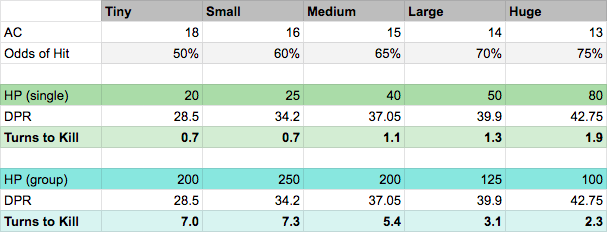
HP Adjustment. You can smooth out the balance by dropping the tiny objects to 10 HP and doubling their Hit Points for every size (20 for small, 40 for medium, 80 for large, 160 for huge).
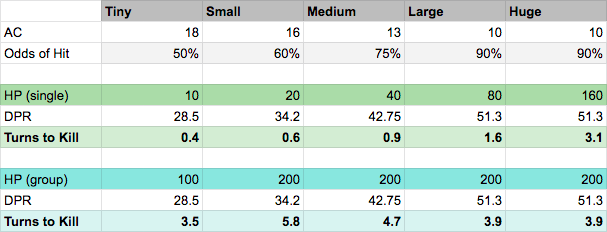
This leaves tiny objects a little less survivable, but don’t forget they can likely fly. The more durable small object is likely to have something resembling legs. If you are not considering any AC adjustments, you can make up for the differences here by ensuring that the small and medium objects pack a little less punch.
The ThinkDM Hack
Putting together a bunch of different ideas that I’ve discussed above, here’s the updated spell table that I’ll be working with in the future:

I made minimal adjustments where necessary. Here’s a change log:
- Scaled HP for everyone.
- Increased AC for medium, large, and huge objects.
- Bumped up the attack bonus for small, medium, and large objects.
- Adjusted the damage (removing modifiers and picking two types of dice).
- STR/DEX were only adjusted to reflect changes in attack rolls.
The benefit of removing modifiers is that it takes a lot of math out of the final damage. You just multiply the number of hits by the number of dice you need to roll, and throw the bones. This speeds up play without necessitating a different system for handling mob attacks.
In case you’re wondering how this hack shakes out in the numbers, here it is plugged into the same charts and tables as above:
Offense
Look at this grouping:

Exactly how we want it. Generally, bigger stuff hits harder. You’ll see a little bit of this ground made up on the defensive side. Similarly, small objects hit a little softer than tiny objects, but tiny objects are more frail. There’s even some overlap between lines as the AC scales up. Tiny objects are also really good against high AC foes, but bottom tier against low-AC foes. These little quirks make for interesting choices between objects.
Admire how precisely we hit our desired 27.5 average damage benchmark:

Defense
On the defensive side, we have a nice progression:

We’re hovering right around the 4 turn longevity benchmark while providing some variety among the object classes. Small objects have the best longevity, but also deal the least damage. Huge objects have the least longevity, but also deal the most damage. While tiny things are easier to kill, they make up ground by having the same damage die as small objects and a higher attack bonus. Interesting quirks emerge that make Animate Objects an interesting choice when you cast it. That’s what we’re looking for.
I hope you enjoyed this spell hack. If you want to support the site and get access to the tools to run your own numbers, support us on the ThinkDM Patreon.
Reblogged this on DDOCentral.
LikeLike
Great rebuild. Saved your site. I’ll be sure to check in. You FB link didn’t work.
LikeLike
My fix for Animate Objects is to only adjusting the HP of the objects:
Tiny = 10HP
Small = 15HP
Medium = 40HP
Large = 115HP
Huge = 260HP
ThinkDM’s “fix” is in the right direction but also nerfs the spell by quite a bit. As the goal was not to nerf the spell but to fix the spell so that tiny objects are not always the best option, I assume this is an uninteded concequence. My fix leaves the tiny objects as the damaging powerhouse they are, but also makes them the least durable option. The huge object is now most durable but still does the least amount of damage.
Overall I increased the total amount of HP you can put on the field for the various sizes combined, because I moved the HP from the high AC objects to the low AC objects (total: 910HP vs 1020HP). However the average amount of rounds survived for all the various sizes combined is still a bit lower than for the original spell (24.07 vs 23.68) so that balances out nicely.
Comparing the Animated Objects spell to other summoning spells is a better comparison. Making the comparisons below I consider this fix balanced but you can make the comparisons yourself:
– The 10 tiny and small objects can be compared to the 8 CR1/4 blink dogs that can be summoned by a 4th level Conjure Woodland Beings spell or 16 CR1/4 Giant owls that can be summoned with a 5th level Conjure animals spell.
– The 5 medium objects can be comparable to the 4 CR1 Giant Hyena’s that can be summoned by a 5th level Conjure Animals spell.
– The 2 large objects (+ smaller object[s]) can be compared to 2 CR2 Giant constrictor snakes that can be summoned by a 5th level Conjure Animals spell.
– The 1 huge object (+ smaller object[s]) can be is compared to the 1 CR5 large elemental that can be summoned by a 5th level Conjure Elemental spell.
As for the general problem of many summons bogging down combat, use a program to auto calculate hits and damage dealt.
LikeLike
As explained in the article, the spell damage and object hit points were balanced using other summoning spells, as well as the spell damage guidance in the Dungeon Master’s Guide. The reason the original spell was unbalanced was because the Tiny and Small options are far too offensively powerful for the spell level. Bringing those in line with the other options actually balanced the spell so it’s power matches other spells.
LikeLike
Thanks for your reply. I guess I missed the point where your intention was to also nerf the spell, that explains the choices you made. There’s discussions elsewhere on whether or not Animate Objects is OP or not.
I personally find the comparison to Conjure Animals, Conjure Woodland Beings, and Conjure Elemental a lot more logical than the comparison to Summon Celestial Spirit and Spirit Weapon, but to each their own. I just wanted to share this as a simpler solution for people who didn’t have the goal to nerf the spell.
LikeLike
I would argue Conjure Woodland Beings and Conjure animals as well as the topic, Animate objects, need to be nerfed. These spells allow full casters to enjoy more sustained damage than virtually any martial character, regardless of their build or any other factors, at any time, just by virtue of choosing and casting the spell. These spells subvert what classes and roles were limited to, strengths and weakness, decisions in character creation, and just give virtually all the advantage and versatility to full casters that can cast them.
LikeLike
I have a feeling that this is why they made the Summon _____ spells with the built-in stat blocks.
LikeLike
Pretty good fix. There’s a few other factors that should also be considered though. The difficulty or likeliness of having the objects where you want them and when you need them there to animate them. This transcends even being a costly or rare spell component in most cases. The Tiny size are completely trivial with a free action at any place and any time and are like an easy spell component. 10 small being arguably the hardest to achieve and least and likely to find in place, and the rest being also fairly difficult or rare to find. Second, the damage of similar level AoE spells and how that effects the defense. The small and the tiny will most likely have most if not all die to a 5th level fireball, or cone of cold or similar. Making the small have arguably the worst defense, followed by tiny. Follow up to the 3rd factor, the amount of actions the objects can soak up if they are attacked or attempted to kill. One action can likely kill most if not all of the small or tiny objects, where as the larger they get the more actions you’d expect when you factor in what monsters/NPC of similar level can are likely to do. If the NPCs are spending their actions to make attacks into 18AC objects, this will likely be a great boon to the players at this level. Lastly, the ease at which each object can attack the desired targets. The Tiny gaining a huge advantage over the small in this department by being able to fit more than 1 per 5x5ft square, and the small only being able to fit one, and the large and huge likely unable to move to many desired positions and not able to get off all the most desired attacks.
Considering all these factors, the Tiny come out the best in 3 out of 4 of them, and small come out the worst in 3 of 4 of them. I would probably reduce the tiny to 1-5HP and bump up the damage on the rest substantially as they are rather demanding and rare. The player should get rewarded in some way for finding an opportunity and way to animate these objects at the right place and time. The Tiny are just a given at all times and should be the worst generally. They still by virtue of their tiny size enjoy a massive maneuverability and attack density advantage over all of them.
LikeLike